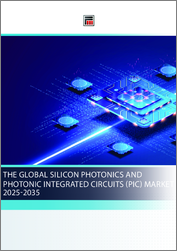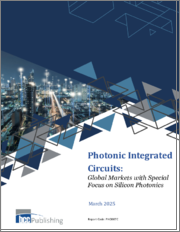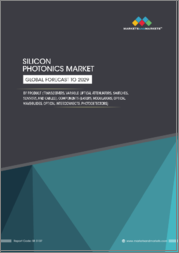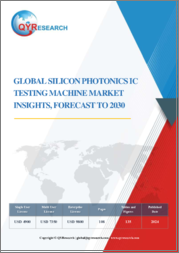
|
시장보고서
상품코드
1602074
실리콘 포토닉스 시장 : 제품 유형, 컴포넌트, 도파관, 최종 용도별 - 세계 예측(2025-2030년)Silicon Photonics Market by Product Type (Optical Engines, Optical Multiplexers, Optical Transceivers), Component (Laser, Optical Modulators, Photodetectors), Waveguide, End-use - Global Forecast 2025-2030 |
||||||
실리콘 포토닉스 시장은 2023년에 19억 5,000만 달러로 평가되며, 2024년에는 23억 3,000만 달러에 달할 것으로 예측되며, CAGR 20.34%로 성장하며, 2030년에는 71억 4,000만 달러에 달할 것으로 예측됩니다.
실리콘 포토닉스는 실리콘을 이용해 빛을 유도하고 조작하는 것으로, 기존의 전자 신호와 달리 특히 비용 효율이 높고 컴팩트하며 다용도하다는 점에서 광통신의 혁명적인 기술로 부상했습니다. 실리콘 포토닉스의 필요성은 클라우드 컴퓨팅, 데이터센터, 통신 네트워크의 확대로 인해 고속 데이터 전송에 대한 수요가 급증하고 있기 때문입니다. 실리콘 포토닉스의 용도는 고성능 컴퓨팅 환경의 데이터 통신부터 의료 진단 및 국방 분야의 센싱에 이르기까지 다양합니다. 또한 통신, 헬스케어, 가전, 자동차 산업까지 그 최종 용도가 확대되고 있습니다. 실리콘 포토닉스 시장의 성장에 영향을 미치는 주요 요인으로는 인터넷 사용의 급격한 증가, 5G 네트워크와 같은 첨단 통신 인프라의 개발, R&D 투자 증가 등을 들 수 있습니다. 더 높은 데이터 대역폭 용량에 대한 미충족 수요와 AI 및 머신러닝 알고리즘과 포토닉스의 통합으로 인해 비즈니스 기회가 창출되고 있습니다. 이러한 기회를 활용할 준비가 되어 있는 기업은 특히 데이터센터와 집적 광회로 분야에서 업계내 기술적 교차점을 강화하기 위한 협업과 파트너십에 초점을 맞추어야 합니다.
| 주요 시장 통계 | |
|---|---|
| 기준년[2023] | 19억 5,000만 달러 |
| 예측년[2024] | 23억 3,000만 달러 |
| 예측년[2030] | 71억 4,000만 달러 |
| CAGR(%) | 20.34% |
그러나 높은 초기 제조 비용, 기존 전자기기와의 통합 문제, 열 관리 문제 등의 제약이 시장 성장에 큰 걸림돌로 작용하고 있습니다. 또한 복잡한 실리콘 포토닉 시스템을 다룰 수 있는 숙련된 전문가가 부족하다는 점도 빠른 시장 확대를 가로막는 요인입니다. 하이브리드 포토닉 집적 연구, 그래핀과 같은 신소재 연구, 실리콘의 효율성을 보완하는 3D 포토닉 칩 프린팅과 같은 새로운 제조 기술 개발을 통해 혁신이 이루어질 수 있습니다. 현재 시장은 역동적인 경쟁과 급속한 기술 발전이 특징이며, 기업이 적응력과 선견지명을 유지하는 것이 매우 중요합니다. 에너지 효율이 높은 광소자 개발 및 칩 수준의 집적도 향상과 같은 분야는 경쟁 우위를 유지하고 미래 성장에 집중하는 시장 기업에게 유리한 잠재력을 제공합니다.
시장 역학: 빠르게 진화하는 실리콘 포토닉스 시장의 주요 시장 인사이트 공개
실리콘 포토닉스 시장은 수요 및 공급의 역동적인 상호작용을 통해 변화하고 있습니다. 이러한 시장 역학의 진화를 이해함으로써 기업은 정보에 입각한 투자 결정을 내리고, 전략적 의사결정을 정교화하며, 새로운 비즈니스 기회를 포착할 수 있습니다. 이러한 동향을 종합적으로 파악함으로써 기업은 정치적, 지역적, 기술적, 사회적, 경제적 영역 전반에 걸친 다양한 리스크를 줄일 수 있으며, 소비자 행동과 그것이 제조 비용 및 구매 동향에 미치는 영향을 보다 명확하게 이해할 수 있습니다.
- 시장 성장 촉진요인
- 데이터 전송 강화에 대한 실리콘 포토닉스에 대한 수요 증가
- 실리콘 포토닉 트랜시버를 통한 전력 절감에 대한 요구 증가
- 시장 성장 억제요인
- 실리콘 포토닉스 집적회로의 제조 비용 상승
- 시장 기회
- 실리콘 포토닉스 솔루션 생산량 증가를 위한 투자 및 자금 조달 급증
- LiDAR 칩의 신기술의 지속적인 통합
- 시장 과제
- 온칩 레이저 통합의 복잡성 및 열 영향의 위험성
Portre's Five Forces: 실리콘 포토닉스 시장 공략을 위한 전략적 툴
Portre's Five Forces 프레임워크는 시장 상황경쟁 구도를 이해하는 중요한 툴입니다. Portre's Five Forces 프레임워크는 기업의 경쟁력을 평가하고 전략적 기회를 탐색할 수 있는 명확한 방법을 제공합니다. 이 프레임워크는 기업이 시장내 세력도를 평가하고 신규 사업의 수익성을 판단하는 데 도움이 됩니다. 이러한 인사이트을 통해 기업은 강점을 활용하고, 약점을 해결하고, 잠재적인 도전을 피하고, 보다 강력한 시장 포지셔닝을 확보할 수 있습니다.
PESTLE 분석 : 실리콘 포토닉스 시장의 외부 영향력 파악
외부 거시 환경 요인은 실리콘 포토닉스 시장의 성과 역학을 형성하는 데 매우 중요한 역할을 합니다. 정치적, 경제적, 사회적, 기술적, 법적, 환경적 요인에 대한 분석은 이러한 영향을 탐색하는 데 필요한 정보를 제공하며, PESTLE 요인을 조사함으로써 기업은 잠재적 위험과 기회를 더 잘 이해할 수 있습니다. 이러한 분석을 통해 기업은 규제, 소비자 선호도, 경제 동향의 변화를 예측하고 선제적이고 능동적인 의사결정을 내릴 준비를 할 수 있습니다.
시장 점유율 분석 실리콘 포토닉스 시장 경쟁 구도 파악
실리콘 포토닉스 시장의 상세한 시장 점유율 분석을 통해 벤더의 성과를 종합적으로 평가할 수 있습니다. 기업은 매출, 고객 기반, 성장률과 같은 주요 지표를 비교하여 경쟁적 위치를 파악할 수 있습니다. 이 분석은 시장의 집중화, 단편화 및 통합 추세를 파악할 수 있으며, 공급업체는 치열한 경쟁 속에서 자신의 입지를 강화할 수 있는 전략적 의사결정을 내리는 데 필요한 인사이트을 얻을 수 있습니다.
FPNV 포지셔닝 매트릭스 실리콘 포토닉스 시장에서의 벤더 성과 평가
FPNV 포지셔닝 매트릭스는 실리콘 포토닉스 시장에서 벤더를 평가할 수 있는 중요한 툴입니다. 이 매트릭스를 통해 비즈니스 조직은 벤더의 비즈니스 전략과 제품 만족도를 기반으로 평가하여 목표에 부합하는 정보에 입각한 의사결정을 내릴 수 있으며, 4개의 사분면으로 벤더를 명확하고 정확하게 세분화하여 전략적에 가장 적합한 파트너와 솔루션을 식별할 수 있습니다. 전략적에 가장 적합한 파트너와 솔루션을 식별할 수 있습니다.
전략 분석 및 추천 실리콘 포토닉스 시장에서의 성공을 위한 전략 분석 및 권장 사항
실리콘 포토닉스 시장 전략 분석은 세계 시장에서 입지를 강화하고자 하는 기업에게 필수적입니다. 주요 자원, 역량 및 성과 지표를 검토함으로써 기업은 성장 기회를 식별하고 개선할 수 있습니다. 이러한 접근 방식은 경쟁 환경의 과제를 극복하고 새로운 비즈니스 기회를 활용하여 장기적인 성공을 거둘 수 있는 체계를 구축할 수 있도록 도와줍니다.
이 보고서는 주요 관심 분야를 포괄하는 시장에 대한 종합적인 분석을 제공합니다. :
1. 시장 침투도 : 현재 시장 환경의 상세한 검토, 주요 기업의 광범위한 데이터, 시장 도달 범위 및 전반적인 영향력 평가.
2. 시장 개척도: 신흥 시장에서의 성장 기회를 파악하고, 기존 분야의 확장 가능성을 평가하며, 미래 성장을 위한 전략적 로드맵을 제공합니다.
3. 시장 다각화 : 최근 제품 출시, 미개척 지역, 업계의 주요 발전, 시장을 형성하는 전략적 투자를 분석합니다.
4. 경쟁 평가 및 정보 : 경쟁 구도를 철저히 분석하여 시장 점유율, 사업 전략, 제품 포트폴리오, 인증, 규제 당국의 승인, 특허 동향, 주요 기업의 기술 발전 등을 검토합니다.
5. 제품 개발 및 혁신 : 미래 시장 성장을 가속할 것으로 예상되는 첨단 기술, 연구개발 활동 및 제품 혁신을 강조합니다.
이해관계자들이 충분한 정보를 바탕으로 의사결정을 내릴 수 있도록 다음과 같은 중요한 질문에 대한 답변도 제공합니다. :
1. 현재 시장 규모와 향후 성장 전망은?
2. 최고의 투자 기회를 제공하는 제품, 부문, 지역은?
3. 시장을 형성하는 주요 기술 동향과 규제의 영향은?
4. 주요 벤더 시장 점유율과 경쟁 포지션은?
5.벤더 시장 진입 및 철수 전략의 원동력이 되는 수입원과 전략적 기회는 무엇인가?
목차
제1장 서문
제2장 조사 방법
제3장 개요
제4장 시장 개요
제5장 시장 인사이트
- 시장 역학
- 성장 촉진요인
- 성장 억제요인
- 기회
- 과제
- 시장 세분화 분석
- Porter's Five Forces 분석
- PESTEL 분석
- 정치
- 경제
- 사회
- 기술
- 법률
- 환경
제6장 실리콘 포토닉스 시장 : 제품 유형별
- 광학 엔진
- 광멀티플렉서
- 광 트랜시버
- 도파관
제7장 실리콘 포토닉스 시장 : 컴포넌트별
- 레이저
- 광변조기
- 광검출기
- 파장 분할 다중 필터
제8장 실리콘 포토닉스 시장 : 도파관별
- 1,310-1,550NM
- 400-1,500NM
- 900-7,000NM
제9장 실리콘 포토닉스 시장 : 최종 용도별
- 자동차
- 가전
- 방위와 보안
- 헬스케어와 생명과학
- IT 및 통신
제10장 아메리카의 실리콘 포토닉스 시장
- 아르헨티나
- 브라질
- 캐나다
- 멕시코
- 미국
제11장 아시아태평양의 실리콘 포토닉스 시장
- 호주
- 중국
- 인도
- 인도네시아
- 일본
- 말레이시아
- 필리핀
- 싱가포르
- 한국
- 대만
- 태국
- 베트남
제12장 유럽, 중동 및 아프리카의 실리콘 포토닉스 시장
- 덴마크
- 이집트
- 핀란드
- 프랑스
- 독일
- 이스라엘
- 이탈리아
- 네덜란드
- 나이지리아
- 노르웨이
- 폴란드
- 카타르
- 러시아
- 사우디아라비아
- 남아프리카공화국
- 스페인
- 스웨덴
- 스위스
- 터키
- 아랍에미리트
- 영국
제13장 경쟁 구도
- 시장 점유율 분석 2023
- FPNV 포지셔닝 매트릭스, 2023
- 경쟁 시나리오 분석
- 전략 분석과 제안
기업 리스트
- AIM Photonics
- AIO Core Co., Ltd.
- Ayar Labs, Inc.
- Broadcom Inc.
- Cadence Design Systems, Inc.
- Cisco Systems, Inc.
- Coherent Corp.
- FormFactor, Inc.
- GlobalFoundries Inc.
- Hamamatsu Photonics, K. K.
- Hewlett Packard Enterprise(HPE)
- Huawei Technologies Co., Ltd.
- IMEC
- Intel Corporation
- International Business Machines Corporation
- Lumentum Operations LLC
- MACOM Technology Solutions Holdings, Inc. :
- MACOM Technology Solutions Inc.
- Marvell Technology, Inc.
- MRSI Systems
- Nokia Corporation
- OSCPS Motion Sensing Inc.
- Sicoya GmbH
- Skorpios Technologies Inc
- STMicroelectronics N.V.
- Sumitomo Electric Industries, Ltd.
- Tower Semiconductor Ltd.
- VLC Photonics S.L. by Hitachi, Ltd.
The Silicon Photonics Market was valued at USD 1.95 billion in 2023, expected to reach USD 2.33 billion in 2024, and is projected to grow at a CAGR of 20.34%, to USD 7.14 billion by 2030.
Silicon photonics involves the use of silicon to guide and manipulate light-eschewing traditional electronic signals-and has emerged as a revolutionary technology in optical communications, particularly due to its cost-effective, compact, and versatile nature. The necessity of silicon photonics is driven by burgeoning demand for high-speed data transmission, as cloud computing, data centers, and telecommunication networks expand. Its applications span from data communication in high-performance computing environments to sensing in medical diagnostics and defense sectors. Additionally, its end-use scope extends to telecommunications, healthcare, consumer electronics, and automotive industries. Key influencers for growth in the silicon photonics market include the exponential rise in internet usage, the development of advanced telecommunications infrastructure such as 5G networks, and increased investments in research and development. Opportunities arise from unmet needs for higher data bandwidth capacities and the integration of photonics with AI and machine learning algorithms. Companies poised to capitalize on these opportunities should focus on collaborations and partnerships to enhance the technological intersections within the industry, particularly in data centers and integrated photonic circuits.
| KEY MARKET STATISTICS | |
|---|---|
| Base Year [2023] | USD 1.95 billion |
| Estimated Year [2024] | USD 2.33 billion |
| Forecast Year [2030] | USD 7.14 billion |
| CAGR (%) | 20.34% |
However, limitations such as high initial manufacturing costs, integration challenges with existing electronics, and thermal management issues pose significant barriers to market growth. Furthermore, a shortage of skilled professionals to handle complex silicon photonic systems also hinders rapid deployment. Innovation can be advanced through research into hybrid photonic integration, exploring new materials like graphene, or developing novel fabrication techniques such as 3D photonic chip printing that supplement silicon's efficiency. The market is currently characterized by dynamic competition and rapid technological advancements, making it crucial for businesses to remain adaptable and forward-thinking. Areas such as the development of energy-efficient photonic devices and enhancing chip-level integration offer lucrative potential for market players focused on sustaining competitive advantage and driving future growth.
Market Dynamics: Unveiling Key Market Insights in the Rapidly Evolving Silicon Photonics Market
The Silicon Photonics Market is undergoing transformative changes driven by a dynamic interplay of supply and demand factors. Understanding these evolving market dynamics prepares business organizations to make informed investment decisions, refine strategic decisions, and seize new opportunities. By gaining a comprehensive view of these trends, business organizations can mitigate various risks across political, geographic, technical, social, and economic domains while also gaining a clearer understanding of consumer behavior and its impact on manufacturing costs and purchasing trends.
- Market Drivers
- Increasing demand for silicon photonics in enhancing data transmission
- Surging need to alleviate power consumption using silicon photonic transceivers
- Market Restraints
- Elevated cost of manufacturing Silicon Photonics integrated circuits
- Market Opportunities
- Surging investments and funding for increasing production of silicon photonics solutions
- Ongoing integration of novel technology in LiDAR chips
- Market Challenges
- Complexity in the integration of on-chip laser and risk of thermal effect
Porter's Five Forces: A Strategic Tool for Navigating the Silicon Photonics Market
Porter's five forces framework is a critical tool for understanding the competitive landscape of the Silicon Photonics Market. It offers business organizations with a clear methodology for evaluating their competitive positioning and exploring strategic opportunities. This framework helps businesses assess the power dynamics within the market and determine the profitability of new ventures. With these insights, business organizations can leverage their strengths, address weaknesses, and avoid potential challenges, ensuring a more resilient market positioning.
PESTLE Analysis: Navigating External Influences in the Silicon Photonics Market
External macro-environmental factors play a pivotal role in shaping the performance dynamics of the Silicon Photonics Market. Political, Economic, Social, Technological, Legal, and Environmental factors analysis provides the necessary information to navigate these influences. By examining PESTLE factors, businesses can better understand potential risks and opportunities. This analysis enables business organizations to anticipate changes in regulations, consumer preferences, and economic trends, ensuring they are prepared to make proactive, forward-thinking decisions.
Market Share Analysis: Understanding the Competitive Landscape in the Silicon Photonics Market
A detailed market share analysis in the Silicon Photonics Market provides a comprehensive assessment of vendors' performance. Companies can identify their competitive positioning by comparing key metrics, including revenue, customer base, and growth rates. This analysis highlights market concentration, fragmentation, and trends in consolidation, offering vendors the insights required to make strategic decisions that enhance their position in an increasingly competitive landscape.
FPNV Positioning Matrix: Evaluating Vendors' Performance in the Silicon Photonics Market
The Forefront, Pathfinder, Niche, Vital (FPNV) Positioning Matrix is a critical tool for evaluating vendors within the Silicon Photonics Market. This matrix enables business organizations to make well-informed decisions that align with their goals by assessing vendors based on their business strategy and product satisfaction. The four quadrants provide a clear and precise segmentation of vendors, helping users identify the right partners and solutions that best fit their strategic objectives.
Strategy Analysis & Recommendation: Charting a Path to Success in the Silicon Photonics Market
A strategic analysis of the Silicon Photonics Market is essential for businesses looking to strengthen their global market presence. By reviewing key resources, capabilities, and performance indicators, business organizations can identify growth opportunities and work toward improvement. This approach helps businesses navigate challenges in the competitive landscape and ensures they are well-positioned to capitalize on newer opportunities and drive long-term success.
Key Company Profiles
The report delves into recent significant developments in the Silicon Photonics Market, highlighting leading vendors and their innovative profiles. These include AIM Photonics, AIO Core Co., Ltd., Ayar Labs, Inc., Broadcom Inc., Cadence Design Systems, Inc., Cisco Systems, Inc., Coherent Corp., FormFactor, Inc., GlobalFoundries Inc., Hamamatsu Photonics, K. K., Hewlett Packard Enterprise (HPE), Huawei Technologies Co., Ltd., IMEC, Intel Corporation, International Business Machines Corporation, Lumentum Operations LLC, MACOM Technology Solutions Holdings, Inc.:, MACOM Technology Solutions Inc., Marvell Technology, Inc., MRSI Systems, Nokia Corporation, OSCPS Motion Sensing Inc., Sicoya GmbH, Skorpios Technologies Inc, STMicroelectronics N.V., Sumitomo Electric Industries, Ltd., Tower Semiconductor Ltd., and VLC Photonics S.L. by Hitachi, Ltd..
Market Segmentation & Coverage
This research report categorizes the Silicon Photonics Market to forecast the revenues and analyze trends in each of the following sub-markets:
- Based on Product Type, market is studied across Optical Engines, Optical Multiplexers, Optical Transceivers, and Waveguides.
- Based on Component, market is studied across Laser, Optical Modulators, Photodetectors, and Wavelength-Division Multiplexing Filters.
- Based on Waveguide, market is studied across 1,310-1,550 NM, 400-1,500 NM, and 900-7,000 NM.
- Based on End-use, market is studied across Automotive, Consumer Electronics, Defense & Security, Healthcare & Life Sciences, and IT & Telecommunications.
- Based on Region, market is studied across Americas, Asia-Pacific, and Europe, Middle East & Africa. The Americas is further studied across Argentina, Brazil, Canada, Mexico, and United States. The United States is further studied across California, Florida, Illinois, New York, Ohio, Pennsylvania, and Texas. The Asia-Pacific is further studied across Australia, China, India, Indonesia, Japan, Malaysia, Philippines, Singapore, South Korea, Taiwan, Thailand, and Vietnam. The Europe, Middle East & Africa is further studied across Denmark, Egypt, Finland, France, Germany, Israel, Italy, Netherlands, Nigeria, Norway, Poland, Qatar, Russia, Saudi Arabia, South Africa, Spain, Sweden, Switzerland, Turkey, United Arab Emirates, and United Kingdom.
The report offers a comprehensive analysis of the market, covering key focus areas:
1. Market Penetration: A detailed review of the current market environment, including extensive data from top industry players, evaluating their market reach and overall influence.
2. Market Development: Identifies growth opportunities in emerging markets and assesses expansion potential in established sectors, providing a strategic roadmap for future growth.
3. Market Diversification: Analyzes recent product launches, untapped geographic regions, major industry advancements, and strategic investments reshaping the market.
4. Competitive Assessment & Intelligence: Provides a thorough analysis of the competitive landscape, examining market share, business strategies, product portfolios, certifications, regulatory approvals, patent trends, and technological advancements of key players.
5. Product Development & Innovation: Highlights cutting-edge technologies, R&D activities, and product innovations expected to drive future market growth.
The report also answers critical questions to aid stakeholders in making informed decisions:
1. What is the current market size, and what is the forecasted growth?
2. Which products, segments, and regions offer the best investment opportunities?
3. What are the key technology trends and regulatory influences shaping the market?
4. How do leading vendors rank in terms of market share and competitive positioning?
5. What revenue sources and strategic opportunities drive vendors' market entry or exit strategies?
Table of Contents
1. Preface
- 1.1. Objectives of the Study
- 1.2. Market Segmentation & Coverage
- 1.3. Years Considered for the Study
- 1.4. Currency & Pricing
- 1.5. Language
- 1.6. Stakeholders
2. Research Methodology
- 2.1. Define: Research Objective
- 2.2. Determine: Research Design
- 2.3. Prepare: Research Instrument
- 2.4. Collect: Data Source
- 2.5. Analyze: Data Interpretation
- 2.6. Formulate: Data Verification
- 2.7. Publish: Research Report
- 2.8. Repeat: Report Update
3. Executive Summary
4. Market Overview
5. Market Insights
- 5.1. Market Dynamics
- 5.1.1. Drivers
- 5.1.1.1. Increasing demand for silicon photonics in enhancing data transmission
- 5.1.1.2. Surging need to alleviate power consumption using silicon photonic transceivers
- 5.1.2. Restraints
- 5.1.2.1. Elevated cost of manufacturing Silicon Photonics integrated circuits
- 5.1.3. Opportunities
- 5.1.3.1. Surging investments and funding for increasing production of silicon photonics solutions
- 5.1.3.2. Ongoing integration of novel technology in LiDAR chips
- 5.1.1. Drivers
- 5.1.4. Challenges
- 5.1.4.1. Complexity in the integration of on-chip laser and risk of thermal effect
- 5.2. Market Segmentation Analysis
- 5.2.1. Product Type: Growing usage of optical transceivers for miniaturizing optical devices
- 5.2.2. Components: Increasing demand for silicon-based laser in optical networks
- 5.2.3. Waveguide: Rising preference for 1,310-1,550 NM waveguide in telecommunications for high precision and stability
- 5.2.4. End-use: Extending applications of silicon photonics in healthcare & life Sciences due to improved medical imaging accuracy
- 5.3. Porter's Five Forces Analysis
- 5.3.1. Threat of New Entrants
- 5.3.2. Threat of Substitutes
- 5.3.3. Bargaining Power of Customers
- 5.3.4. Bargaining Power of Suppliers
- 5.3.5. Industry Rivalry
- 5.4. PESTLE Analysis
- 5.4.1. Political
- 5.4.2. Economic
- 5.4.3. Social
- 5.4.4. Technological
- 5.4.5. Legal
- 5.4.6. Environmental
6. Silicon Photonics Market, by Product Type
- 6.1. Introduction
- 6.2. Optical Engines
- 6.3. Optical Multiplexers
- 6.4. Optical Transceivers
- 6.5. Waveguides
7. Silicon Photonics Market, by Component
- 7.1. Introduction
- 7.2. Laser
- 7.3. Optical Modulators
- 7.4. Photodetectors
- 7.5. Wavelength-Division Multiplexing Filters
8. Silicon Photonics Market, by Waveguide
- 8.1. Introduction
- 8.2. 1,310-1,550 NM
- 8.3. 400-1,500 NM
- 8.4. 900-7,000 NM
9. Silicon Photonics Market, by End-use
- 9.1. Introduction
- 9.2. Automotive
- 9.3. Consumer Electronics
- 9.4. Defense & Security
- 9.5. Healthcare & Life Sciences
- 9.6. IT & Telecommunications
10. Americas Silicon Photonics Market
- 10.1. Introduction
- 10.2. Argentina
- 10.3. Brazil
- 10.4. Canada
- 10.5. Mexico
- 10.6. United States
11. Asia-Pacific Silicon Photonics Market
- 11.1. Introduction
- 11.2. Australia
- 11.3. China
- 11.4. India
- 11.5. Indonesia
- 11.6. Japan
- 11.7. Malaysia
- 11.8. Philippines
- 11.9. Singapore
- 11.10. South Korea
- 11.11. Taiwan
- 11.12. Thailand
- 11.13. Vietnam
12. Europe, Middle East & Africa Silicon Photonics Market
- 12.1. Introduction
- 12.2. Denmark
- 12.3. Egypt
- 12.4. Finland
- 12.5. France
- 12.6. Germany
- 12.7. Israel
- 12.8. Italy
- 12.9. Netherlands
- 12.10. Nigeria
- 12.11. Norway
- 12.12. Poland
- 12.13. Qatar
- 12.14. Russia
- 12.15. Saudi Arabia
- 12.16. South Africa
- 12.17. Spain
- 12.18. Sweden
- 12.19. Switzerland
- 12.20. Turkey
- 12.21. United Arab Emirates
- 12.22. United Kingdom
13. Competitive Landscape
- 13.1. Market Share Analysis, 2023
- 13.2. FPNV Positioning Matrix, 2023
- 13.3. Competitive Scenario Analysis
- 13.3.1. Jabil expand its silicon photonics capabilities to support advanced AI and data center technologies
- 13.3.2. Taiwan's silicon photonics alliance accelerates AI energy solutions with global standards and R&D collaborations
- 13.3.3. Coherent Corp introduces high-efficiency lasers to enhance silicon photonics transceivers
- 13.3.4. Sivers Semiconductors to combine Sivers' Photonics subsidiary with byNordic
- 13.3.5. Intel and Source Photonics propel 800G transceivers to the forefront of datacentre solutions
- 13.3.6. Samsung Foundry's 2027 roadmap enhances AI integration with 1.4nm process and silicon photonics advancements
- 13.3.7. DustPhotonics secures USD 24 million in Series B funding to advance silicon photonics for next-gen data centers
- 13.3.8. Infleqtion propels quantum technology commercialization with strategic silicon photonics acquisitions
- 13.3.9. TSMC-Broadcom-Nvidia alliance advancing silicon photonics for high-speed AI data transmission
- 13.3.10. Tower Semiconductor and InnoLight's strategic partnership advances the development of next-gen silicon photonics-based optical transceivers
- 13.4. Strategy Analysis & Recommendation
- 13.4.1. STMicroelectronics N.V.
- 13.4.2. Cisco Systems, Inc.
- 13.4.3. Broadcom Inc.
- 13.4.4. Intel Corporation
Companies Mentioned
- 1. AIM Photonics
- 2. AIO Core Co., Ltd.
- 3. Ayar Labs, Inc.
- 4. Broadcom Inc.
- 5. Cadence Design Systems, Inc.
- 6. Cisco Systems, Inc.
- 7. Coherent Corp.
- 8. FormFactor, Inc.
- 9. GlobalFoundries Inc.
- 10. Hamamatsu Photonics, K. K.
- 11. Hewlett Packard Enterprise (HPE)
- 12. Huawei Technologies Co., Ltd.
- 13. IMEC
- 14. Intel Corporation
- 15. International Business Machines Corporation
- 16. Lumentum Operations LLC
- 17. MACOM Technology Solutions Holdings, Inc.:
- 18. MACOM Technology Solutions Inc.
- 19. Marvell Technology, Inc.
- 20. MRSI Systems
- 21. Nokia Corporation
- 22. OSCPS Motion Sensing Inc.
- 23. Sicoya GmbH
- 24. Skorpios Technologies Inc
- 25. STMicroelectronics N.V.
- 26. Sumitomo Electric Industries, Ltd.
- 27. Tower Semiconductor Ltd.
- 28. VLC Photonics S.L. by Hitachi, Ltd.



















